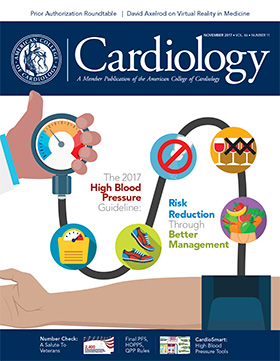Editor's Corner | Blood Pressure Measurement - A Perspective
 Nikolai Korotkoff
Nikolai Korotkoff
This month, a new guideline on high blood pressure from the ACC and American Heart Association (AHA) was presented at AHA’s annual conference, held in Anaheim. Like other hypertension guidelines, this update is not without controversy. Although we could measure systolic blood pressure by noting when the pulse disappeared as it diminishes with increasing pressure in the occluded cuff, a method for measuring the diastolic blood pressure was described in 1905 by Nikolai Korotkoff. This method gave us an accurate approach for recording both systolic and diastolic blood pressure by interpreting the sounds created by blood flowing through a partially occluded brachial artery.
Korotkoff performed a number of experiments to prove that the sounds originated from the brachial artery and not from the aortic valve. His method was widely adopted throughout the world as the standard method for measuring systolic and diastolic blood pressure. For many years, a clinic or hospital was characterized by the presence of a mercury manometer arranged to allow the arm cuff to be inflated and the Korotkoff sounds auscultated by a physician or nurse to record blood pressure.
One of the first things we learned in our clinical training was how to measure blood pressure using the Korotkoff sounds. Although cumbersome to use, there was no question that the mercury column was providing an accurate pressure measurement. But concerns about mercury toxicity, let to the adoption of aneroid pressure gages that were more convenient, non-toxic and more portable, but required periodic assessment of their accuracy.
In more recent times, we’ve adopted oscillometry as a more convenient tool for measuring blood pressure. This method records the oscillations produced by the arterial pulse wave after the arm pressure falls below systolic pressure. While the method was not considered to be accurate initially, more sophisticated pressure wave analysis has increased its accuracy to the point where the oscillometric method is the most common for recording blood pressure at the bedside and in the outpatient environment. Nowadays, a clinic visit often starts with a medical assistant using the automated system to measure blood pressure, as well as heart rate, arterial oxygen saturation and body temperature — and all the values are immediately and automatically recorded in the electronic health record. The data is readily displayed for the clinician and patient to view. And it presents the physician with a rapid review of the patient’s present vital signs and, when requested, past data for comparison.

But is this the right way to assess blood pressure on a repeated basis when we follow patients for hypertension? The clinical trials that evaluate therapy and goals of blood pressure often involve multiple pressure measurements, a period of quiet before the measurements are made and sometimes repeated automated blood pressure measurements with no medical attendant present. Most busy cardiology practices don’t have the time to allow the patient to sit or lie quietly for five to 10 minutes before the measurements and commonly record only one blood pressure measurement.
We have used home-measured blood pressure to provide more frequent measurements and ones from an environment more like the patient’s usual environment than a patient examining room. These studies support the use of home blood pressure measurements in managing hypertension. The use of telemedicine allows patients to record their data at home, transmit the information periodically to their care provider and receive immediate feedback on the status of their blood pressure.
Such telemedicine systems have been shown to improve blood pressure adherence and allow patients to achieve therapy goals more frequently than patients provided usual care. You can also find blood pressure measuring devices in pharmacies and fitness centers that use a pulse wave analysis to record both systolic and diastolic blood pressure from a single inflation of a fixed diameter cuff that, in comparisons with an oscillometric method, seems to provide reliable measures of blood pressure.
The next step in accessibility for the patient moves us into the world of wearable devices. We have watches that will record fitness measures like walking and running speed and distance, heart rate during exercise, calories consumed and even measures of sleep activity. A wearable blood pressure monitoring device is now available that looks like a smartwatch and provides many of the measures usually found in a smartwatch — but this new “watch” also records blood pressure without an arm blood pressure cuff. It still inflates a small cuff built into the wrist band of the watch and records systolic and diastolic pressure during the cuff deflation. This unit will record a number of other health measures and report them via Bluetooth or wireless technology to a health information database.
The biotechnology world has brought many tools that will improve the health of our patients. The fact that this technology is available as a personal wearable device would at first glance appear to solve the accessibility issues for many of our patients. So far, however, the technology has not found wide acceptance in bringing improved health care to our patients with hypertension. Our next task will be to create motivation for our patients to use the technology to monitor and improve their health. This is our greatest challenge in this world of more and more sophisticated devices.
Tweet this article: Tweet
Alfred A. Bove, MD, PhD, MACC, is professor emeritus of medicine at Temple University School of Medicine in Philadelphia, and a former president of the ACC.
Keywords: ACC Publications, Cardiology Magazine, Blood Pressure, Heart Rate, Pulse Wave Analysis, Mercury, Oxygen, Brachial Artery, Body Temperature, Walking, American Heart Association, Oscillometry, Fitness Centers, Wireless Technology, Motivation, Accidental Falls, Pharmacies, Aortic Valve, Outpatients, Blood Pressure Determination, Systole, Hypertension, Auscultation, Running, Telemedicine, Electronic Health Records, Biotechnology, Ambulatory Care
< Back to Listings

